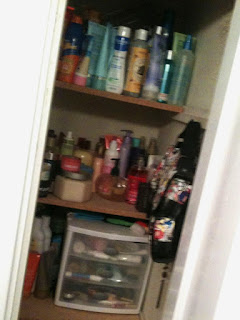 |
| Mold growth on unpreserved body cream. Photo courtesy of Soap Queen. |
Those of you that
follow me on Facebook may have noticed a post recently, in which a friend shared
this link to blogger Cara's recipe for DIY eye shadow primer. I checked it out, because I'm all about Do-It-Yourself lately (blame
Pinterest). I am, however, also very concerned with safety and sanitation, especially where the eyes are concerned, so when I read the recipe (a mixture of Chapstick, liquid foundation and cornstarch) a warning bell went off.
As I explained on my Facebook page (and in the comments on MaskCara), cornstarch has a very high sugar content. Bacteria and fungus love sugar, so cornstarch is essentially an all-you-can-eat buffet for them, which means they multiply. Of course, it did occur to me that any commercial foundation used in the recipe would have a certain amount of preservative, but I wondered: is that amount enough to preserve the entire batch and keep the eyes safe from creepy-crawlies?
Without knowing the exact foundation, preservative & concentration, my research abilities were limited, so I decided to go straight to the experts. Through the modern miracle of social media, I posed the question to a few cosmetic chemists that I know- the fabulous
Kelly Dobos,
Chemists Corner's Perry Romanowski (author of
The Beauty Aisle Insider and
Can You Get Hooked on Lip Balm?) and UK based cosmetic scientist,
Colin Sanders. To say there was a consensus would be misleading, but I think it's safe to tell you that the chemists agreed that a DIY primer formula was not without its risks. While Kelly and Perry felt like the cornstarch-based formula was chancy (especially around the sensitive eye area), Colin wasn't quite so conservative, saying he felt the risk, in reality, was very low. The whole discussion prompted Colin to cover the topic
on his own website, and of course, I had to share.
Now, I'm not just tooting my own horn here (OK, maybe a little). I'm sharing Colin's post and our discussion with you because the issue goes well beyond one blogger's post on eye shadow primer. For many beauty-obsessives, the temptation to DIY is strong. The popularity of mass-market "natural" cosmetics is at an all time high, and the explosion of social media has given handmade indie brands the potential to reach millions. Do a quick search on online marketplaces like
Etsy or
ArtFire, and you'll find literally thousands of listings, for everything from eye shadows to soaps to wrinkle serums. Many of these products are unique, effective, high-quality, and most importantly,
safe- but some...aren't.
When brands use readily available ingredients, and in some cases mix them up in kitchens just like ours, the logical conclusion is "why shouldn't I just make this myself?" Often you can (I'm doing exactly that this week for my daughter's birthday party favors). It's important to understand, however, the many considerations you need to make if you're going to whip up your own formulations. Just because a product is natural doesn't mean it's without risks (or, for that matter, a better choice than synthetics) and DIYers need to be savvy before playing chemist.
As always, I want to thank Kelly, Colin and Perry for so openly sharing their knowledge, and of course, big thanks to Karen, who originally posted the primer post on my Facebook page!




